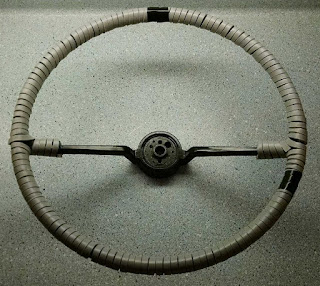I've mentioned at least a few times in other entries that aesthetics are a major factor in a lot of decisions I've made on this project. After years and years of poring through photos of old race cars and noting little details that make them what they are, I want to try to capture at least some of those little details in my project.
One feature that commonly appears on NASCAR stock cars and Trans Am sedans of the mid-'60s is the padded steering wheel. This usually appears to be just a stock steering wheel wrapped with electrical tape. I always used to assume that the steering wheels must just be wrapped in many, many layers of electrical tape, but it may be electrical tape wrapped over some type of padding. Or it may be that they aren't wrapped in electrical tape at all, but rather just something that looks like electrical tape. Either way, I've decided at this point that they are probably wrapped in something to provide some level of padding, and then that padding is covered in electrical tape to hold it all together.
I really wanted to wrap my steering wheel in electrical tape to get that look, but I figured the electrical tape would turn into a sticky mess and get pretty disgusting pretty quickly. So I just figured I'd have to live without a wrapped/padded steering wheel. I thought maybe I'd get a nice leather steering wheel cover to sort of give a similar effect.
But then, when I was unwrapping and re-wrapping wiring harnesses, I noticed that the electrical tape I'd bought just happened to not be anywhere near the sticky mess that other electrical tapes I'd used in the past had been. And that got me to thinking about the steering wheel again....
The photo below shows what the stock '65 Impala steering wheel looks like.
I think it's a pretty stylish deal, with the four chrome bits positioned in pairs on each side, and the chrome horn ring that traces a chrome arc between the spokes of the wheel. I kind of wish they'd had a horn button with the "SS" logo for the SS cars that year, but the leaping Impala logo is pretty slick, too.
For a really legit race car look, I'd have to remove the horn ring and go with a little bit more spartan appearance, as shown below.
But, I'd gotten kind of attached to the look of the horn ring, and it would be easier to make the horn work if I kept the horn ring, so I decided to exercise a little artistic liberty and keep the horn ring.
To pad the steering wheel, I ended up going to Lowe's and buying a roll of foam window seal. The stuff I got is 3/16" thick, 3/8" wide, and comes in a roll 17' long. And as I said above, the key to this whole deal was the electrical tape. The stuff I used on the wiring harnesses, which wasn't a sticky mess, was 3M Highland brand vinyl electrical tape. And the packaging even says it's fire retardant, so ... safety!
I had bought the electrical tape a while back and couldn't remember where I'd bought it from. I tried a couple of parts stores without success and then found it at O'Reilly's.
I did a little bit of last-minute studying, looking at photos of old race car interiors, and I noticed that not everyone wrapped their wheel the same way. For some reason I'd assumed that there would be some kind of a standard approach, but I guess it shouldn't be surprising that different people had different ideas about how to do it. I found some photos where the whole wheel was wrapped, others where just the outer ring of the wheel was wrapped, and one photo where just the spokes and the center hub were wrapped, but the outer ring was not. That surprised me a bit, but it also opened the door to wrap my wheel however I liked. I decided to wrap all the exposed portions of the wheel itself, and then to install the horn ring on the wrapped wheel.
As it turned out, one 17' roll of the foam window seal wasn't enough to finish the job, so I wrapped as much as I could with one roll, taped the ends in place with electrical tape, then went and bought another roll of foam to finish the rest of the wheel. When I was done with that, it looked like the photo below.
Next I wrapped wrapped the wheel with electrical tape, and the photo below shows it loosely in place in the car.
Next photo shows the horn ring loosely in place.
I was really pretty happy with out it turned out. I think that if I really wanted it to be more authentic, another layer of foam and another layer of electrical tape would get the thickness about where it should be. But I've always liked the skinny steering wheels on old cars, so I think I'll stick with just the one layer of foam.
I am a little bit worried that the first time I park the car outside in the sun, the electrical tape will still melt into a sticky mess, but the beauty of the window foam padding is that it should protect the steering wheel from the stickiness of the electrical tape, and I can just unwrap it if it ever does get messy.
So at that point, I had the wheel wrapped and loosely in place on the steering column. But, as I mentioned a couple posts ago, I had some problems when it came time to actually torque the steering wheel in place. The photo below shows a side view of the steering wheel as it is installed on the column.
As I said in that other entry:
I used an aftermarket steering column from a company called "ididit," which is a popular choice for aftermarket steering columns. But it means that the factory steering wheel doesn't fit the aftermarket column perfectly, so they have a little adapter kit to make the wheel look better on their column. It consists mainly of a little chrome ring that you essentially glue to the back of your steering wheel, and it takes up the difference in diameter between the wheel and the column. It's a dress-up ring, in essence, as its only function is to make things look nicer.
The arrow in the photo below indicates the trim ring from the adapter kit.
The text from the other entry continues:
Well, I got the ring stuck on the back of the steering wheel, and put everything together and torqued the wheel down and ... the dress-up ring was clamped between the edge of the column and the horn ring so tightly that it was difficult to turn the steering wheel.
When I wrote that, I wondered if anyone would be able to follow my attempt at describing the problem. Well, the arrow in the photo below indicates what I was calling "the edge of the column"...
...and the next photo below this indicates the edge of the horn ring that was clamping down on the trim ring from the other side.
Back to the text from the other entry:
So, I took everything apart, and I started trying to grind a couple of reliefs into the dress-up ring, where it contacts the steering wheel, in order to lift it away from the edge of the steering column.
The arrow in the photo below points out where the reliefs were ground in the trim ring, in order to move the trim ring away from the edge of the steering column.
I started out cutting the reliefs with a cutoff wheel on a Dremel. That removed material pretty quickly, but it really didn't look very good. I tried a test fit, though, as described in the other entry:
I finished that and went to put everything back together, but I realized before I even had it assembled that the back edge of the horn ring was still going to interfere with the dress-up ring, and the interference would actually be worse now, since I was essentially moving the dress-up ring forward. So I assembled everything without the horn ring, just to check the clearance with the edge of the column. It was improved, but still had some interference. So, I pulled everything part again, took some more material out of the reliefs I'd made on the dress-up ring, and cut something like an eighth of an inch off of the back of the horn ring.
It was actually two or three iterations before everything fit, but at some point I decided to use a file on the reliefs in the trim ring, and that really improved their appearance. The file made it easier to keep the relief surface flat, which gives a better appearance from the side. I used a digital caliper to check the thickness of each relief in three places to make sure they were a uniform thickness across, and also equal in thickness to each other.
The arrow in the photo below indicates the edge of the horn ring where I cut about an eighth of an inch off to create clearance for the trim ring.
After all that, the pieces all fit together pretty well, with no interference.
One more photo below, to show what the end result looks like now.



















No comments:
Post a Comment